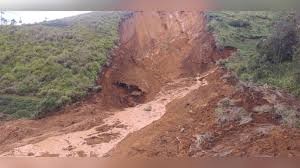 Delhi, May 31 — Torrential rainfall has wreaked havoc across Mizoram’s capital, Aizawl, triggering deadly landslides, road collapses, and widespread disruptions to daily life. A tragic incident in the Thuampui area marked the beginning of the crisis when a retaining wall at a laborers’ camp collapsed around 7 am, killing a 37-year-old man and injuring another.
Delhi, May 31 — Torrential rainfall has wreaked havoc across Mizoram’s capital, Aizawl, triggering deadly landslides, road collapses, and widespread disruptions to daily life. A tragic incident in the Thuampui area marked the beginning of the crisis when a retaining wall at a laborers’ camp collapsed around 7 am, killing a 37-year-old man and injuring another.
The intense and continuous downpour has destabilized hillsides, causing landslides and rockfalls in multiple parts of the region. Key roadways, including inter-district and national highways, have been blocked by debris, effectively cutting off several routes and delaying transportation. In Mauchar village within Aizawl district, at least two houses were severely damaged due to land subsidence. Meanwhile, in the Bethel Veng locality of Champhai district, a home was swept away by a sudden mudslide, underscoring the widespread danger across the hilly terrain.
Emergency crews have been deployed to affected areas to clear blocked roads and remove landslide debris, though ongoing rainfall continues to hinder progress. No further casualties have been reported so far. However, the risk of additional landslides remains high as the soil across the state remains heavily saturated.
One of the most visibly impacted areas is Berawtlang, a popular tourist destination, where parts of the road infrastructure have collapsed. These damages have further compounded the disruption to travel and access in and out of Aizawl city.
In response to the escalating situation, authorities have implemented emergency measures. All educational institutions across several districts have been ordered shut as a precautionary step. State disaster management officials remain on high alert, closely monitoring rainfall patterns and issuing regular updates to residents.
The unfolding situation in Aizawl highlights the growing vulnerability of hilly and urban regions to extreme weather events. As rescue operations continue and assessments are conducted, the city braces for more challenges in the coming days.
